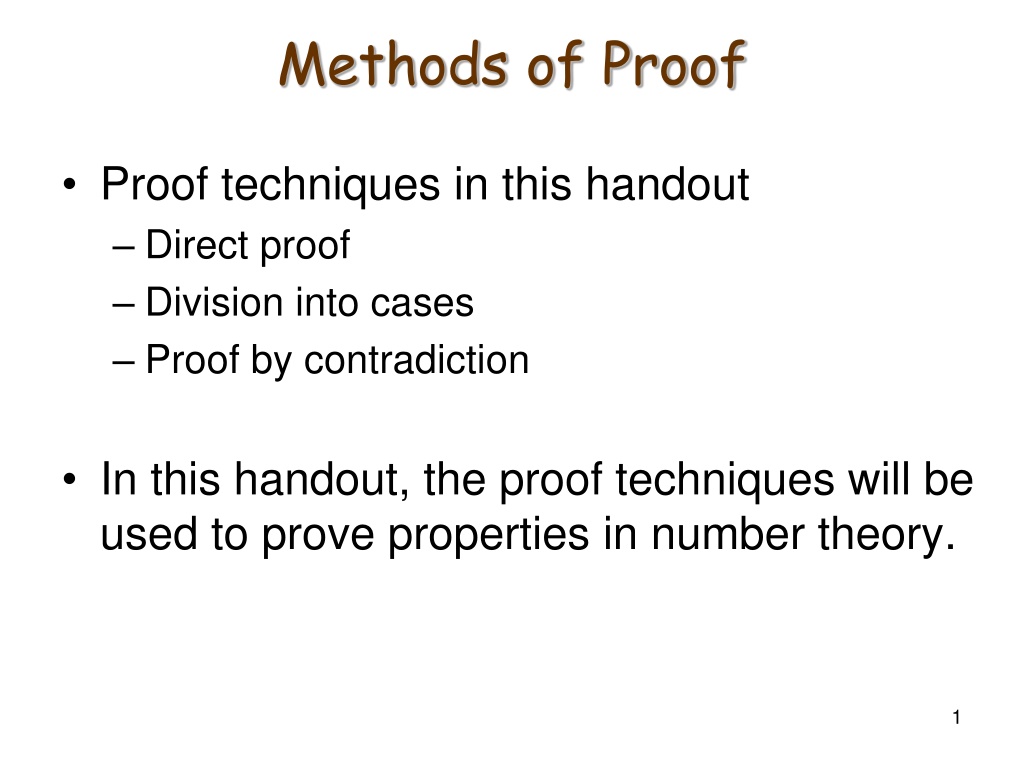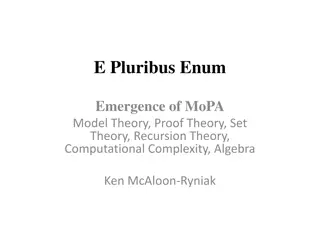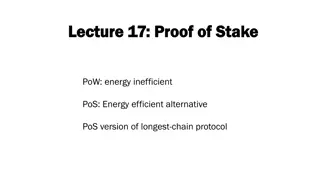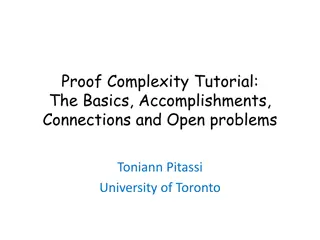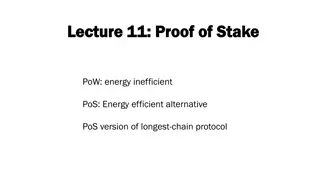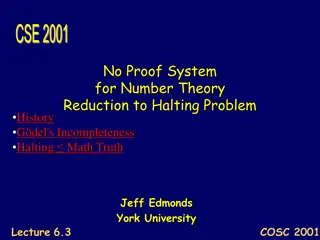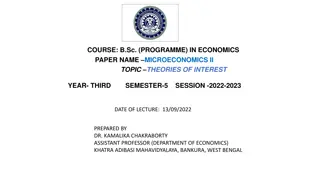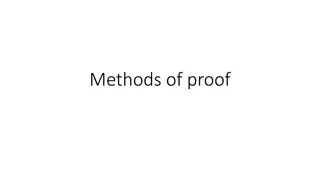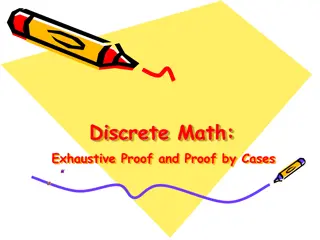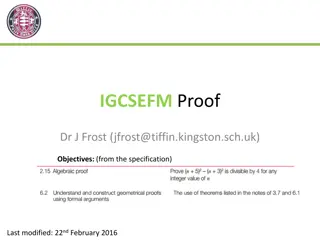Proof Techniques in Number Theory
Explore methods of proof, such as direct proof and proof by contradiction, to establish properties in number theory. Learn about even and odd integers, the method of direct proof, writing proofs effectively, common mistakes to avoid, and types of mathematical statements like theorems, propositions, corollaries, and lemmas. Delve into divisibility concepts in number theory.
Download Presentation

Please find below an Image/Link to download the presentation.
The content on the website is provided AS IS for your information and personal use only. It may not be sold, licensed, or shared on other websites without obtaining consent from the author.If you encounter any issues during the download, it is possible that the publisher has removed the file from their server.
You are allowed to download the files provided on this website for personal or commercial use, subject to the condition that they are used lawfully. All files are the property of their respective owners.
The content on the website is provided AS IS for your information and personal use only. It may not be sold, licensed, or shared on other websites without obtaining consent from the author.
E N D
Presentation Transcript
Methods of Proof Proof techniques in this handout Direct proof Division into cases Proof by contradiction In this handout, the proof techniques will be used to prove properties in number theory. 1
Even and Odd Integers Definition: An integer n is even iff an integer k such that n=2k; is odd iff an integer k such that n=2k+1. Ex: If x and y are integers, is even or odd? 7 2 4 + xy x 2 2
Method of Direct Proof To prove a statement: x D if P(x) then Q(x). Suppose x is a particular but arbitrarily chosen element of D for which P(x) is true; Show the conclusion Q(x) is true by using definitions; previously established results; rules of logical inference. 3
Method of Direct Proof (Ex.) Show x Zif x is odd Proof: Suppose x is an arbitrarily chosen odd integer. Then x=2k+1 for some integer k. (by definition) So 3x+9 = 3(2k+1)+9 (by substitution) = 6k+3+9 (by distributive law) = 2(3k+6) (by factoring out a 2) (*) 3k+6 is an integer. Hence 3x+9 is even based on (*), (**) and definition of even integers. (this is what we needed to show) then 3x+9 is even. (**)
Directions for writing proofs 1) Write the theorem to be proved. 2) Clearly mark the beginning of your proof with the word Proof. 3) Make your proof self-contained. (Identify all variables used in the proof; state the sources of outside facts). 4) Write proofs in complete English sentences. 5
Common mistakes in proofs Arguing from examples Using same letter to mean two different things Jumping to a conclusion (without adequate reasons) 6
Types of Mathematical Statements Theorems: Very important statements that have many and varied consequences. Propositions: Less important and consequential. Corollaries: The truth can be deduced almost immediately from other statements. Lemmas: Don t have much intrinsic interest but help to prove other theorems. 7
Divisibility Definition: For n,d Z and d 0 we say that n is divisible by d iffn=d k for some k Z . Alternative ways to say: n is a multiple of d , d is a factor of n , d is a divisor of n , d divides n . Notation: d | n . Examples: 6|48, 5|5, -4|8, 7|0, 1|9 . 8
Properties of Divisibility For x Z, 1|x . For x Zs.t. x 0, x|0 . For a,b,c Z, if a|b and a|c then a|(b+c) . Transitivity: For a,b,c Z, if a|b and b|c then a|c . 9
Quotient-Remainder Theorem Theorem: For n Z andd Z+ ! q,r Z such that n=d q+r and 0 r<d. q is called quotient; r is called remainder. Notation: q = n div d; r = n mod d. Examples: 1) 53 = 8 6+5. Hence 53 div 8 = 6; 53 mod 8 = 5. 2)-29 = 7 (-5)+6.Hence -29 div 7 = -5; -29 mod 7 = 6. 10
Example of using div and mod Last year Halloween was on Tuesday. Q.: What day is Halloween this year? Solution: There are 366 days between 10/31/23 and 10/31/24. 366 mod 7 = 2. Thus, if 10/31/23 was Tuesday then 10/31/24 is Thursday. 11
Proof Technique: Division into Cases Suppose at some stage of a proof we know that A1 or A2 or A3or or An is true; want to deduce a conclusion C. Use division into cases: Show A1 C, A2 C, , An C. Conclude that C is true. 12
Division into Cases: Example Proposition: If n Z such that Proof: Suppose n Z s.t. neither of 2 or 3 divide n. By quotient-remainder theorem, exactly one of the following is true: a) n=6k, b) n=6k+1, c) n=6k+2, d) n=6k+3, e) n=6k+4, f) n=6k+5 for some integer k. (3) n can t be 6k, 6k+2 or 6k+4 because in that case 2 | n (which contradicts (1) ). (4) n can t be 6k+3 because in that case 3 | n (which contradicts (1) ). neither of 2 or 3 divide n, then n2 mod 12 = 1. (1) (2) (5) 13
Division into Cases: Example(cont.) Proof(cont.): Based on (3), (4) and (5), Let s show (2) for each of these two cases. Case 1: Suppose n=6k+1. Then n2 = (6k+1)2=36k2+12k+1 (by basic algebra) = 12(3k2+k)+1 Let p=3k2+k. Then p is an integer. n2 = 12p+1 . ( by substitution in (6) ) Hence n2 mod 12 = 1 by quotient-remainder th-m. Case 2: Suppose n=6k+5. (exercise) either n=6k+1 or n=6k+5. (6)
Method of Proof by Contradiction 1. Suppose the statement to be proved is false. 2. Show that this supposition logically leads to a contradiction. 3. Conclude that the statement to be proved is true. Example of proof by contradiction. Theorem: There is no greatest integer. The proof on the board. We will see several contradiction proofs in graph theory. 15
